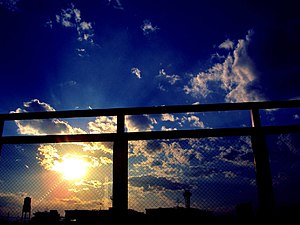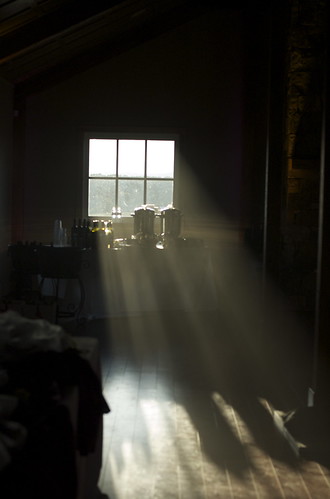Image taken from TraderZed's Flickr photostream under CC license
Unlike north and south window, which have roughly the same properties all day long, the light coming from east and west windows changes drastically throughout the day. As a result, the solutions to the problems of eastern and western light can change as well. When trying to decide what to do with a window on an eastern or western wall, it is necessary to ask yourself: how do I use this room? When do I use it? What experience do I want here during the day?
There may be some rooms in your house that you only use at certain times of day, or only on weekends. Most of us are only in the bedroom in the morning and evening, when eastern and western light are most disparate. The office, on the other hand, is typically only used during the day, when light from these windows is bright but a little more diffuse (except in the late afternoon, when western light can be very intense and warm).
 Image via Wikipedia
Image via Wikipediaprevious night's dreams (what does it mean that in my dream the suburban street I grew up on looked like the lower east side of NYC?) 15 minutes of high contrast light can be energizing. If your bedroom has an eastern window, ask yourself: do you like being woken by the rising sun, or do you prefer to black out your room and hit the snooze button a few times?
A western window gets that direct orange light in the evening, and here again you have to think about how and when you use the room. At sunset, the average building is as warm as it is going to get, having absorbed sunlight all day long, so that direct western sun can be awfully hot. If you live in the far north in the winter, this may be as pleasant as sitting by the fireplace, and the view of the sky may be spectacular at sunset. In the New Mexico desert, in the middle of August, you probably just want that light to go away and bug somebody else, view or not.
Eastern and Western windows are extremely versatile, and versatile solutions work best. Light blue curtains would cool off and mellow the sun rise and sunset light, while red, orange or yellow curtains would enhance the fireplace effect. Blinds are also ideal for these windows, allowing for complete control of the light. Highly reflective or metallic horizontal blinds allow you to bounce the light up to the ceiling or down to the floor, if you prefer. These windows are more complex, but with complexity comes increased opportunity to shape your experience.


Great post as usual Gabe! A little additional info I learned in architecture school for those interested: Apparently, exterior shading devices are more efficient than interior because the heat from the sun can be reflected before entering the house. Also, in East and West facing windows, the low angle of the sun means that vertical blinds provide shade more effectively than horizontal blinds. :)
ReplyDeletewhat are the negatives of east and west facing windows
ReplyDeleteSandy - that depends greatly on the context, the use of the room, etc. Generally, however, west facing windows get a bad rap because of thermal gain in the summer. As the sun is setting, the day is as hot as it is going to get, and the sun will shine straight into a west facing window, heating up everything it shines upon. The hotter the weather, the more awful this affect is, and it is particularly bad in office buildings which have high cooling loads already. This effect can be mitigated to a great degree (for buildings that are a only few stories, anyway) by planting deciduous trees on the west side of a building, which will block some sun in every season except winter, when the leaves will fall off and let the warming effect occur. Near the equator, where winters don't really get cold, you may want tropical evergreens to block that sunshine year round. For taller buildings, some sort of external screen can be used to absorbs a percentage of the sunshine outside the building envelope.
ReplyDeleteEast facing windows are less of a problem thermally, as the sun shines directly in when the day is at its coldest, and a little warming is probably okay. However, the quality of the light may be very harsh and high contrast, ill suited to working conditions or most tasks. This will pass as you approach noon, however, and the light quality will mellow out for the rest of the day.
Wow, the way the light comes through that window is incredible. I wish my home had more windows. The builder really skimped on windows and I am regretting it now. Perhaps I will install some "aftermarket" windows if that is even possible.
ReplyDeletehttp://www.wtfarybros.com/pages/products/window_andersen.html
A very good and informative article indeed. It helps me a lot to enhance my knowledge, I really like the way the writer presented his views.
ReplyDeletewindow blinds houston
Thanks 4 the windows
ReplyDelete